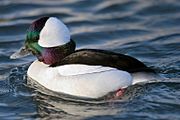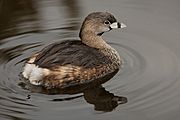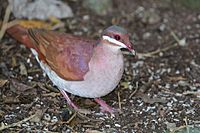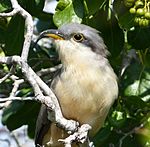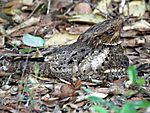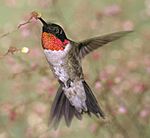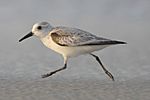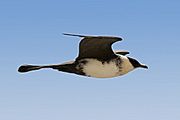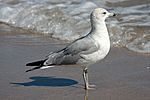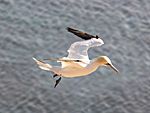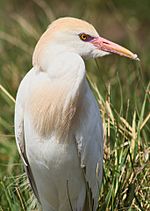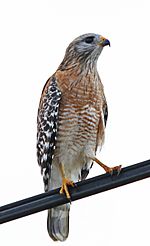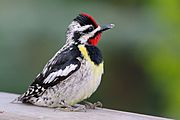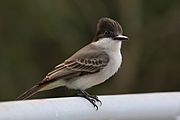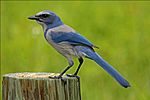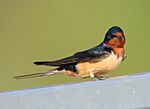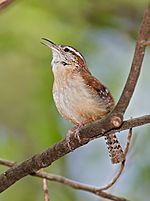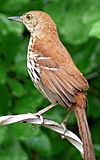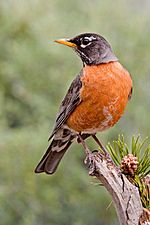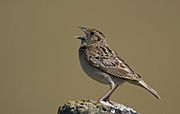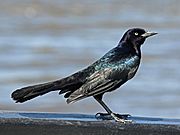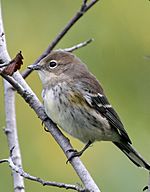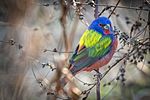List of birds of Biscayne National Park facts for kids
This is a list of all the different types of birds found in Biscayne National Park in Florida. This list was put together by the National Park Service and includes birds seen up to December 21, 2017. There are 213 bird species here. Some of them are "accidental" (meaning they don't usually live here but visited by chance), and some are "introduced" (meaning humans brought them here).
The birds are listed in a special order, like how scientists group them. This order comes from the Check-list of North and Middle American Birds, published by the American Ornithological Society (AOS). The names of the bird families come from the Clements taxonomy.
Here are some special notes you'll see next to some bird names:
- (A) Accidental: This bird rarely visits Florida.
- (I) Introduced: Humans brought this bird to North America, and it now lives in Florida.
Contents
- Ducks, Geese, and Waterfowl
- Flamingoes
- Grebes
- Pigeons and Doves
- Cuckoos
- Nightjars and Allies
- Hummingbirds
- Rails, Gallinules, and Coots
- Stilts and Avocets
- Oystercatchers
- Plovers and Lapwings
- Sandpipers and Allies
- Skuas and Jaegers
- Gulls, Terns, and Skimmers
- Tropicbirds
- Loons
- Southern Storm-Petrels
- Shearwaters and Petrels
- Storks
- Frigatebirds
- Boobies and Gannets
- Anhingas
- Cormorants and Shags
- Pelicans
- Herons, Egrets, and Bitterns
- Ibises and Spoonbills
- New World Vultures
- Osprey
- Hawks, Eagles, and Kites
- Barn-Owls
- Owls
- Kingfishers
- Woodpeckers
- Falcons and Caracaras
- New World and African Parrots
- Tyrant Flycatchers
- Vireos, Shrike-Babblers, and Erpornis
- Shrikes
- Crows, Jays, and Magpies
- Swallows
- Kinglets
- Waxwings
- Gnatcatchers
- Wrens
- Mockingbirds and Thrashers
- Starlings
- Thrushes and Allies
- Old World Sparrows
- Wagtails and Pipits
- Finches, Euphonias, and Allies
- Longspurs and Snow Buntings
- New World Sparrows
- Spindalises
- Troupials and Allies
- New World Warblers
- Cardinals and Allies
- See Also
Ducks, Geese, and Waterfowl
Order: Anseriformes Family: Anatidae
This family includes ducks, geese, and swans. These birds are great in water! They have webbed feet, flat beaks, and special oily feathers that keep them dry.
- Fulvous whistling-duck, Dendrocygna bicolor
- Snow goose, Anser caerulescens
- Brant, Branta bernicla (A)
- Mute swan, Cygnus olor (I)
- Muscovy duck, Cairina moschata (I)
- Blue-winged teal, Spatula discors
- American wigeon, Mareca americana
- Mottled duck, Anas fulvigula
- Northern pintail, Anas acuta
- Canvasback, Aythya valisineria
- Lesser scaup, Aythya affinis
- Bufflehead, Bucephala albeola
- Hooded merganser, Lophodytes cucullatus
- Red-breasted merganser, Mergus serrator
Flamingoes
Order: Phoenicopteriformes Family: Phoenicopteridae
Flamingoes are tall, social wading birds, usually about 3 to 5 feet (1 to 1.5 meters) tall. They live in groups and filter their food, like tiny shellfish and algae, from the water. Their unique beaks are shaped to scoop up food while held upside-down!
- American flamingo, Phoenicopterus ruber
Grebes
Order: Podicipediformes Family: Podicipedidae
Grebes are small to medium-sized diving birds that live in freshwater. They have special lobed toes that make them excellent swimmers and divers. However, because their feet are set far back on their bodies, they are quite clumsy on land.
- Pied-billed grebe, Podilymbus podiceps
- Horned grebe, Podiceps auritus
Pigeons and Doves
Order: Columbiformes Family: Columbidae
Pigeons and doves are birds with strong bodies, short necks, and thin beaks. They have a soft, fleshy area at the base of their bill called a cere.
- Rock pigeon, Columba livia (I)
- White-crowned pigeon, Patagioenas leucocephala
- Eurasian collared-dove, Streptopelia decaocto (I)
- Common ground dove, Columbina passerina
- Key West quail-dove, Geotrygon chrysia (A)
- White-winged dove, Zenaida asiatica
- Mourning dove, Zenaida macroura
Cuckoos
Order: Cuculiformes Family: Cuculidae
This family includes cuckoos and roadrunners. These birds come in different sizes but usually have slender bodies, long tails, and strong legs.
- Smooth-billed ani, Crotophaga ani
- Yellow-billed cuckoo, Coccyzus americanus
- Mangrove cuckoo, Coccyzus minor
- Black-billed cuckoo, Coccyzus erythropthalmus
Nightjars and Allies
Order: Caprimulgiformes Family: Caprimulgidae
Nightjars are medium-sized birds that are active at night. They usually build their nests on the ground. They have long wings, short legs, and very small beaks. Their soft feathers are colored to help them blend in with tree bark or leaves.
- Common nighthawk, Chordeiles minor
- Chuck-will's-widow, Antrostomus carolinensis
- Eastern whip-poor-will, Antrostomus vociferus
Hummingbirds
Order: Apodiformes Family: Trochilidae
Hummingbirds are tiny birds famous for hovering in the air. They flap their wings incredibly fast. They are the only birds that can fly backward!
- Ruby-throated hummingbird, Archilochus colubris
Rails, Gallinules, and Coots
Order: Gruiformes Family: Rallidae
This is a large family of small to medium-sized birds. They include rails, crakes, coots, and gallinules. Most of these birds live in thick plants near lakes, swamps, or rivers. They are often shy and hard to spot. They usually have strong legs with long toes and short, rounded wings. They are not very strong fliers.
- Clapper rail, Rallus crepitans
- Common gallinule, Gallinula galeata
- American coot, Fulica americana
Stilts and Avocets
Order: Charadriiformes Family: Recurvirostridae
This family includes avocets and stilts, which are large wading birds. Avocets have long legs and long beaks that curve upward. Stilts have extremely long legs and long, thin, straight beaks.
- Black-necked stilt, Himantopus mexicanus
- American avocet, Recurvirostra americana
Oystercatchers
Order: Charadriiformes Family: Haematopodidae
Oystercatchers are large, easy-to-spot, and noisy birds. They have strong beaks that they use to smash open or pry open molluscs like oysters.
- American oystercatcher, Haematopus palliatus
Plovers and Lapwings
Order: Charadriiformes Family: Charadriidae
This family includes plovers, dotterels, and lapwings. They are small to medium-sized birds with compact bodies, short thick necks, and long, pointed wings. You usually find them in open areas, especially near water.
- Black-bellied plover, Pluvialis squatarola
- Killdeer, Charadrius vociferus
- Semipalmated plover, Charadrius semipalmatus
- Piping plover, Charadrius melodus
- Wilson's plover, Charadrius wilsonia
Sandpipers and Allies
Order: Charadriiformes Family: Scolopacidae
This is a large and diverse family of small to medium-sized shorebirds. It includes sandpipers, curlews, and snipes. Most of them eat small bugs they find in mud or sand. Different lengths of legs and beaks allow many species to feed in the same area without competing for food.
- Whimbrel, Numenius phaeopus
- Ruddy turnstone, Arenaria interpres
- Red knot, Calidris canutus
- Sanderling, Calidris alba
- Dunlin, Calidris alpina
- Least sandpiper, Calidris minutilla
- Semipalmated sandpiper, Calidris pusilla
- Western sandpiper, Calidris mauri
- Short-billed dowitcher, Limnodromus griseus
- Wilson's snipe, Gallinago delicata
- Spotted sandpiper, Actitis macularius
- Solitary sandpiper, Tringa solitaria
- Lesser yellowlegs, Tringa flavipes
- Willet, Tringa semipalmata
- Greater yellowlegs, Tringa melanoleuca
- Red-necked phalarope, Phalaropus lobatus
- Red phalarope, Phalaropus fulicarius
Skuas and Jaegers
Order: Charadriiformes Family: Stercorariidae
Skuas are medium to large seabirds. They usually have gray or brown feathers, sometimes with white spots on their wings. They have longish beaks with hooked tips and webbed feet with sharp claws. They are strong, agile fliers.
- Pomarine jaeger, Stercorarius pomarinus
- Parasitic jaeger, Stercorarius parasiticus
Gulls, Terns, and Skimmers
Order: Charadriiformes Family: Laridae
This family includes gulls, terns, and skimmers. They are medium to large seabirds, usually gray or white, often with black marks on their heads or wings. They have strong, longish beaks and webbed feet.
- Bonaparte's gull, Chroicocephalus philadelphia
- Laughing gull, Leucophaeus atricilla
- Ring-billed gull, Larus delawarensis
- Herring gull, Larus argentatus
- Lesser black-backed gull, Larus fuscus
- Great black-backed gull, Larus marinus
- Brown noddy, Anous stolidus
- Sooty tern, Onychoprion fuscata
- Least tern, Sternula antillarum
- Caspian tern, Hydroprogne caspia
- Black tern, Chlidonias niger
- Common tern, Sterna hirundo
- Arctic tern, Sterna paradisaea
- Forster's tern, Sterna forsteri
- Royal tern, Thalasseus maxima
- Sandwich tern, Thalasseus sandvicensis
- Black skimmer, Rynchops niger
Tropicbirds
Order: Phaethontiformes Family: Phaethontidae
Tropicbirds are slender white birds that live over tropical oceans. They have incredibly long central tail feathers. Their long wings and heads have black markings.
- Red-billed tropicbird, Phaeton aethereus (A)
Loons
Order: Gaviiformes Family: Gaviidae
Loons are water birds about the size of a large duck, but they are not related to ducks. Their feathers are mostly gray or black, and they have spear-shaped beaks. Loons swim very well and can fly, but they are clumsy on land because their legs are at the back of their bodies.
- Red-throated loon, Gavia stellata
- Common loon, Gavia immer
Southern Storm-Petrels
Order: Procellariiformes Family: Oceanitidae
Storm-petrels are the smallest seabirds. They are related to petrels. They eat tiny crustaceans and small fish from the ocean's surface, often while hovering. Their flight is fluttery, sometimes like a bat.
- Wilson's storm-petrel, Oceanites oceanicus
Shearwaters and Petrels
Order: Procellariiformes Family: Procellariidae
These are the main group of medium-sized "true petrels." They are known for their tube-like nostrils that are joined together.
- Audubon's shearwater, Puffinus lherminieri
Storks
Order: Ciconiiformes Family: Ciconiidae
Storks are large, heavy wading birds with long legs, long necks, and long, strong beaks. They have wide wingspans. Unlike other wading birds, storks do not have special "powder down" feathers to clean off fish slime. Storks also cannot make sounds because they lack a voice box.
- Wood stork, Mycteria americana
Frigatebirds
Order: Suliformes Family: Fregatidae
Frigatebirds are large seabirds usually found over tropical oceans. They are big, black, or black-and-white, with long wings and deeply forked tails. The males have colorful throat pouches that they can inflate. They cannot swim or walk well, and they can't take off from a flat surface. They have the largest wingspan compared to their body weight of any bird, allowing them to stay in the air for over a week!
- Magnificent frigatebird, Fregata magnificens
Boobies and Gannets
Order: Suliformes Family: Sulidae
This family includes gannets and boobies. Both are medium-large coastal seabirds that dive headfirst into the water to catch fish.
- Brown booby, Sula leucogaster
- Red-footed booby, Sula sula (A)
- Northern gannet, Morus bassanus
Anhingas
Order: Suliformes Family: Anhingidae
Anhingas, also called darters or snakebirds, are water birds similar to cormorants. They have long necks and long, straight beaks. They eat fish and can dive for long periods. Often, they swim with only their neck above the water, looking like a water snake.
- Anhinga, Anhinga anhinga
Cormorants and Shags
Order: Suliformes Family: Phalacrocoracidae
Cormorants are medium to large water birds, usually with dark feathers and colored skin on their faces. Their beak is long, thin, and sharply hooked. They have four webbed toes on each foot.
- Double-crested cormorant, Nannopterum auritum
Pelicans
Order: Pelecaniformes Family: Pelecanidae
Pelicans are very large water birds with a special pouch under their beak. Like other birds in their group, they have four webbed toes.
- American white pelican, Pelecanus erythrorhynchos
- Brown pelican, Pelecanus occidentalis
Herons, Egrets, and Bitterns
Order: Pelecaniformes Family: Ardeidae
This family includes herons, egrets, and bitterns. Herons and egrets are wading birds with long necks and legs. Herons are generally larger, and egrets are smaller. The cattle egret is often seen near cows, eating bugs that the cattle stir up. Bitterns usually have shorter necks and are more secretive. Unlike storks or ibises, these birds fly with their necks pulled back in a curve.
- Great blue heron, Ardea herodias
- Great egret, Ardea alba
- Snowy egret, Egretta thula
- Little blue heron, Egretta caerulea
- Tricolored heron, Egretta tricolor
- Reddish egret, Egretta rufescens
- Cattle egret, Bubulcus ibis
- Green heron, Butorides virescens
- Black-crowned night-heron, Nycticorax nycticorax
- Yellow-crowned night-heron, Nyctanassa violacea
Ibises and Spoonbills
Order: Pelecaniformes Family: Threskiornithidae
This family includes ibises and spoonbills. They have long, broad wings, long bodies, and even longer necks and legs. Their beaks are also long: ibises have downward-curved beaks, while spoonbills have straight, flat beaks.
- White ibis, Eudocimus albus
- Glossy ibis, Plegadis falcinellus
- Roseate spoonbill, Platalea ajaja
New World Vultures
Order: Cathartiformes Family: Cathartidae
New World vultures are not closely related to vultures found in other parts of the world, but they look similar because they adapted to the same lifestyle. Like other vultures, they are scavengers, meaning they eat dead animals. Unlike Old World vultures, New World vultures have a great sense of smell to find carcasses.
- Black vulture, Coragyps atratus
- Turkey vulture, Cathartes aura
Osprey
Order: Accipitriformes Family: Pandionidae
The Osprey family has only one type of bird. Ospreys are fish-eating birds of prey. They have very large, strong, hooked beaks to tear meat, powerful legs, strong claws (talons), and excellent eyesight.
- Osprey, Pandion haliaetus
Hawks, Eagles, and Kites
Order: Accipitriformes Family: Accipitridae
This family includes hawks, eagles, kites, and harriers. They are birds of prey with very large, hooked beaks for tearing meat, strong legs, powerful talons, and sharp eyesight.
- Northern harrier, Circus hudsonius
- Sharp-shinned hawk, Accipiter striatus
- Cooper's hawk, Accipiter cooperii
- Bald eagle, Haliaeetus leucocephalus
- Snail kite, Rostrhamus sociabilis
- Red-shouldered hawk, Buteo lineatus
- Broad-winged hawk, Buteo platypterus
- Short-tailed hawk, Buteo brachyurus
- Red-tailed hawk, Buteo jamaicensis
Barn-Owls
Order: Strigiformes Family: Tytonidae
Barn-owls are medium to large owls. They have big heads and a special heart-shaped face. They also have long, strong legs with powerful talons.
- Barn owl, Tyto alba
Owls
Order: Strigiformes Family: Strigidae
Typical owls are small to large birds of prey that hunt at night and usually live alone. They have large eyes that face forward and big ears. They have a hawk-like beak and a clear circle of feathers around each eye, called a facial disk.
- Eastern screech-owl, Megascops asio
- Great horned owl, Bubo virginianus
- Barred owl, Strix varia
Kingfishers
Order: Coraciiformes Family: Alcedinidae
Kingfishers are medium-sized birds with large heads, long pointed beaks, short legs, and stubby tails.
- Belted kingfisher, Megaceryle alcyon
Woodpeckers
Order: Piciformes Family: Picidae
Woodpeckers are small to medium-sized birds. They have chisel-like beaks, short legs, stiff tails, and long tongues to catch insects. Many woodpeckers tap loudly on tree trunks with their beaks.
- Red-bellied woodpecker, Melanerpes carolinus
- Yellow-bellied sapsucker, Sphyrapicus varius
- Downy woodpecker, Dryobates pubescens
- Northern flicker, Colaptes auratus
- Pileated woodpecker, Dryocopus pileatus
Falcons and Caracaras
Order: Falconiformes Family: Falconidae
This family includes falcons and caracaras. They are birds of prey that hunt during the day. They are different from hawks and eagles because they kill their prey with their beaks, not their claws.
- American kestrel, Falco sparverius
- Merlin, Falco columbarius
- Peregrine falcon, Falco peregrinus
New World and African Parrots
Order: Psittaciformes Family: Psittacidae
Parrots have strong, curved beaks, stand upright, and have strong legs with special clawed feet (two toes forward, two backward). Many parrots are brightly colored. They range in size from about 3 inches (8 cm) to 3 feet (1 meter) long. Most of the over 150 species in this family live in the Americas.
- Monk parakeet, Myiopsitta monachus (I)
Tyrant Flycatchers
Order: Passeriformes Family: Tyrannidae
Tyrant flycatchers are songbirds found across North and South America. They look a bit like flycatchers from other parts of the world but are stronger and have sturdier beaks. Most of them eat insects.
- Great crested flycatcher, Myiarchus crinitus
- La Sagra's flycatcher, Myiarchus sagrae (A)
- Western kingbird, Tyrannus verticalis
- Gray kingbird, Tyrannus dominicensis
- Eastern wood-pewee, Contopus virens
- Eastern phoebe, Sayornis phoebe
Vireos, Shrike-Babblers, and Erpornis
Order: Passeriformes Family: Vireonidae
Vireos are small to medium-sized songbirds found only in the Americas. They are usually greenish and look like wood warblers, but they have heavier beaks.
- White-eyed vireo, Vireo griseus
- Bell's vireo, Vireo bellii
- Yellow-throated vireo, Vireo flavifrons
- Red-eyed vireo, Vireo olivaceus
- Black-whiskered vireo, Vireo altiloquus
Shrikes
Order: Passeriformes Family: Laniidae
Shrikes are songbirds known for catching other birds and small animals. They sometimes impale the parts they don't eat on thorns. A shrike's beak is hooked, like a bird of prey.
- Loggerhead shrike, Lanius ludovicianus
Crows, Jays, and Magpies
Order: Passeriformes Family: Corvidae
This family includes crows, ravens, and jays. These birds are larger than average for songbirds, and some of the bigger ones are very smart.
- Blue jay, Cyanocitta cristata
- American crow, Corvus brachyrhynchos
- Fish crow, Corvus ossifragus
Swallows
Order: Passeriformes Family: Hirundinidae
Swallows are built for catching food while flying. They have slender bodies, long pointed wings, and short beaks with wide mouths. Their feet are better for perching than walking.
- Tree swallow, Tachycineta bicolor
- Northern rough-winged swallow, Stelgidopteryx serripennis
- Purple martin, Progne subis
- Barn swallow, Hirundo rustica
Kinglets
Order: Passeriformes Family: Regulidae
Kinglets are a small family of birds that look a bit like titmice. They are very tiny birds that eat insects. Adult kinglets have colorful crowns on their heads, which is how they got their name.
- Ruby-crowned kinglet, Corthylio calendula
Waxwings
Order: Passeriformes Family: Bombycillidae
Waxwings are birds with soft, silky feathers. Some of their wing feathers have unique red tips that look like sealing wax, giving them their name. These birds live in northern forests. They eat insects in summer and berries in winter.
- Cedar waxwing, Bombycilla cedrorum
Gnatcatchers
Order: Passeriformes Family: Polioptilidae
This family includes gnatcatchers and gnatwrens. They are small songbirds that eat insects.
- Blue-gray gnatcatcher, Polioptila caerulea
Wrens
Order: Passeriformes Family: Troglodytidae
Wrens are small and often hard to see, but they have very loud songs! They have short wings and thin, downward-curved beaks. Many species hold their tails straight up. All wrens eat insects.
- Carolina wren, Thryothorus ludovicianum
- House wren, Troglodytes aedon
Mockingbirds and Thrashers
Order: Passeriformes Family: Mimidae
This family includes thrashers, mockingbirds, and catbirds. They are famous for their amazing ability to copy the songs of many other birds and other sounds they hear outside. These birds usually have dull gray and brown feathers.
- Gray catbird, Dumetella carolinensis
- Brown thrasher, Toxostoma rufum
- Bahama mockingbird, Mimus gundlachii (A)
- Northern mockingbird, Mimus polyglottos
Starlings
Order: Passeriformes Family: Sturnidae
Starlings are small to medium-sized songbirds with strong feet. They fly strongly and directly and often gather in large groups. They prefer open areas and eat insects and fruit. Their feathers are usually dark with a shiny, metallic look.
- European starling, Sturnus vulgaris (I)
- Common myna, Acridotheres tristis (I)
Thrushes and Allies
Order: Passeriformes Family: Turdidae
Thrushes are a group of songbirds that are plump and have soft feathers. They are small to medium-sized birds that eat insects or sometimes everything (omnivores), often finding food on the ground. Many thrushes have beautiful songs.
- Veery, Catharus fuscescens
- Gray-cheeked thrush, Catharus minimus
- Swainson's thrush, Catharus ustulatus
- American robin, Turdus migratorius
Old World Sparrows
Order: Passeriformes Family: Passeridae
Old World sparrows are small songbirds. Generally, sparrows are small, plump, brownish or grayish birds with short tails and strong, short beaks. Sparrows eat seeds, but they also eat small insects.
- House sparrow, Passer domesticus (I)
Wagtails and Pipits
Order: Passeriformes Family: Motacillidae
This family includes wagtails, longclaws, and pipits. They are slender, small songbirds with medium to long tails. They eat insects and find their food on the ground in open areas.
- American pipit, Anthus rubescens
Finches, Euphonias, and Allies
Order: Passeriformes Family: Fringillidae
Finches are songbirds that eat seeds. They are small to medium-sized and have strong, often cone-shaped beaks. They have a bouncy flight, flapping their wings and then gliding with them closed. Most finches sing well.
- American goldfinch, Spinus tristis
Longspurs and Snow Buntings
Order: Passeriformes Family: Calcariidae
This group of songbirds used to be grouped with New World sparrows. However, they are different in several ways and are usually found in open grassy areas.
- Lapland longspur, Calcarius lapponicus (A)
- Smith's longspur, Calcarius pictus (A)
- Chestnut-collared longspur, Calcarius ornatus (A)
- Snow bunting, Plectrophenax nivalis (A)
New World Sparrows
Order: Passeriformes Family: Passerellidae
Until 2017, these birds were considered part of a different family. Most of these species are called sparrows, but they are not closely related to the Old World sparrows. Many of them have unique patterns on their heads.
- Grasshopper sparrow, Ammodramus savannarum
- Savannah sparrow, Passerculus sandwichensis
Spindalises
Order: Passeriformes Family: Spindalidae
The birds in this small family were only officially recognized in 2017. They live in the Greater Antilles islands. One species visits Florida quite often.
- Western spindalis, Spindalis zena (A)
Troupials and Allies
Order: Passeriformes Family: Icteridae
The icterids are a group of small to medium-sized, often colorful, songbirds found only in the Americas. This group includes grackles, New World blackbirds, and New World orioles. Most of them have black as their main feather color, often brightened with yellow, orange, or red.
- Bobolink, Dolichonyx oryzivorus
- Orchard oriole, Icterus spurius
- Baltimore oriole, Icterus galbula
- Red-winged blackbird, Agelaius phoeniceus
- Brown-headed cowbird, Molothrus ater
- Common grackle, Quiscalus quiscula
- Boat-tailed grackle, Quiscalus major
New World Warblers
Order: Passeriformes Family: Parulidae
Wood warblers are a group of small, often colorful, songbirds found only in the Americas. Most live in trees, but some live on the ground. Most birds in this family eat insects.
- Ovenbird, Seiurus aurocapilla
- Worm-eating warbler, Helmitheros vermivorum
- Northern waterthrush, Parkesia noveboracensis
- Black-and-white warbler, Mniotilta varia
- Orange-crowned warbler, Leiothlypis celata
- Common yellowthroat, Geothlypis trichas
- American redstart, Setophaga ruticilla
- Cape May warbler, Setophaga tigrina
- Northern parula, Setophaga americana
- Magnolia warbler, Setophaga magnolia
- Bay-breasted warbler, Setophaga castanea
- Yellow warbler, Setophaga petechia
- Blackpoll warbler, Setophaga striata
- Black-throated blue warbler, Setophaga caerulescens
- Palm warbler, Setophaga palmarum
- Yellow-rumped warbler, Setophaga coronata
- Yellow-throated warbler, Setophaga dominica
- Prairie warbler, Setophaga discolor
- Black-throated gray warbler, Setophaga nigrescens (A)
- Black-throated green warbler, Setophaga virens
Cardinals and Allies
Order: Passeriformes Family: Cardinalidae
Cardinals are a family of strong, seed-eating birds with powerful beaks. They usually live in open woodlands. Males and females often have different feather colors.
- Western tanager, Piranga ludoviciana
- Northern cardinal, Cardinalis cardinalis
- Indigo bunting, Passerina cyanea
- Painted bunting, Passerina ciris
- Dickcissel, Spiza americana
See Also
- List of birds of Florida
- List of birds of Everglades National Park
- List of North American birds


